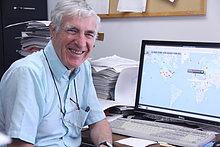Revolutionizing How We Get the News

For those who self-identify as “news junkies,” a web application developed by Distinguished University Professor of computer science Hanan Samet and his students is making it easier to effectively find the national and international stories that matter most to them.
Known as NewsStand, the application lets users search for worldwide news on their computers or iPads with a query interface that is a display of a world map. Someone can search for news in Moscow, for example, by literally looking at Russia on the map and clicking to zoom in on news from that area.
The application, which crawls the web for both written articles and video feeds, has the added benefit of letting users not only read headlines for the city they searched for, but also view more stories from the surrounding area. Readers can also use layers to limit their search to specific topics, such as health, entertainment, business and more.
“What you’re really doing is reading news with a map, so essentially you’re looking at 10,000 newspapers from all over the world,” says Samet, who has an appointment in the university’s Institute for Advanced Computer Studies (UMIACS) and was just honored as the 2014 recipient of the Wallace W. Wallace McDowell Award.
NewsStand—which pulls information from thousands of individual news sources in the form of RSS feeds—is available for free online. Samet, noted for his groundbreaking research in indexing spatial and image databases, is currently working toward making the application available for smartphones.
Samet and two computer science graduate students, Marco Adelfio and Brendan Fruin, have built prototype apps for the iPhone, Android and Windows phone platforms, and are working on fine-tuning the graphics and usability of these apps. That includes figuring out what people expect from their news platforms.
“We try to monitor the various newspapers out there to see who their readers are, how they interpret the news, and what they expect from the news,” Samet says, adding the researchers also need to see how many users they can support on a mobile application.
The key challenge is making sure the correct news is getting posted at the right location.
“The big thing is trying to get all the locations correct and making sure you’re not missing out on a news story because you have, for example, the wrong Dublin,” he says, noting people often only think of Ireland’s capital city, but there is also a Dublin, Calif., and a Dublin, Ohio.
Samet believes NewsStand could soon be a “must have” tool for people who love keeping up with the news locally and worldwide.
“What makes NewsStand so useful is that you don’t have to plug in keywords and you don’t have to know what you’re looking for, you just have to have an idea of an area or topic you want to explore,” Samet says. “What we’re really doing here is exploiting the power of spatial synonyms.”
—Story by Melissa Brachfeld
